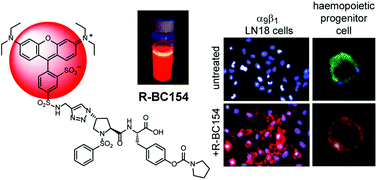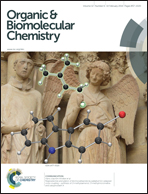Design, synthesis and binding properties of a fluorescent α9β1/α4β1 integrin antagonist and its application as an in vivo probe for bone marrow haemopoietic stem cells†
Abstract
The α9β1 and α4β1 integrin subtypes are expressed on bone marrow haemopoietic stem cells and have important roles in stem cell regulation and trafficking. Although the roles of α4β1 integrin have been thoroughly investigated with respect to HSC function, the role of α9β1 integrin remains poorly characterised. Small molecule fluorescent probes are useful tools for monitoring biological processes in vivo, to determine cell-associated protein localisation and activation, and to elucidate the mechanism of small molecule mediated protein interactions. Herein, we report the design, synthesis and integrin-dependent cell binding properties of a new fluorescent α9β1 integrin antagonist (R-BC154), which was based on a series of N-phenylsulfonyl proline dipeptides and assembled using the Cu(I)-catalyzed azide alkyne cycloaddition (CuAAC) reaction. Using transfected human glioblastoma LN18 cells, we show that R-BC154 exhibits high nanomolar binding affinities to α9β1 integrin with potent cross-reactivity against α4β1 integrin under physiological mimicking conditions. On-rate and off-rate measurements revealed distinct differences in the binding kinetics between α9β1 and α4β1 integrins, which showed faster binding to α4β1 integrin relative to α9β1, but more prolonged binding to the latter. Finally, we show that R-BC154 was capable of binding rare populations of bone marrow haemopoietic stem and progenitor cells when administered to mice. Thus, R-BC154 represents a useful multi-purpose fluorescent integrin probe that can be used for (1) screening small molecule inhibitors of α9β1 and α4β1 integrins; (2) investigating the biochemical properties of α9β1 and α4β1 integrin binding and (3) investigating integrin expression and activation on defined cell phenotypes in vivo.


 Please wait while we load your content...
Please wait while we load your content...